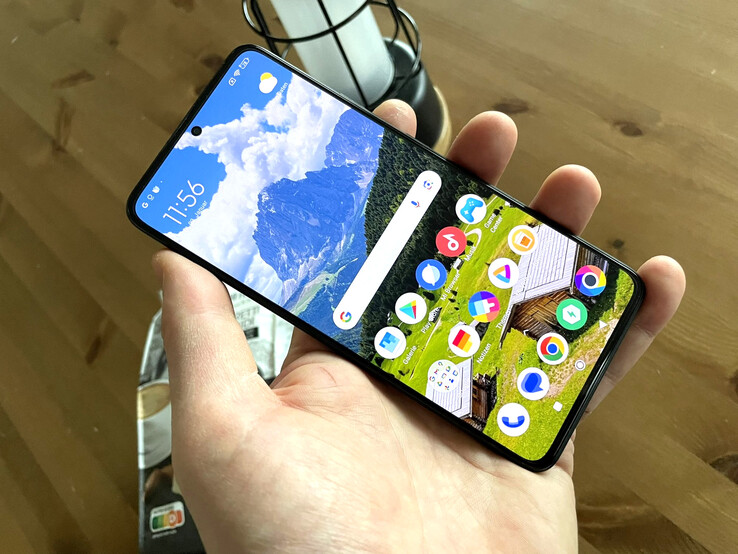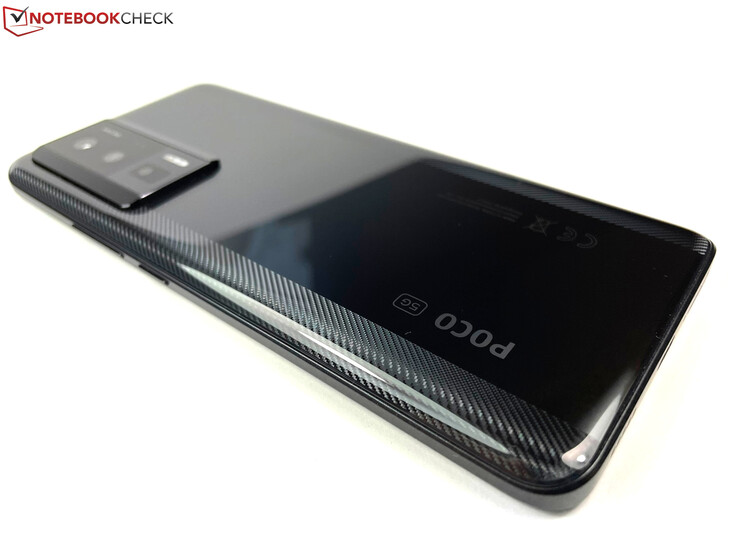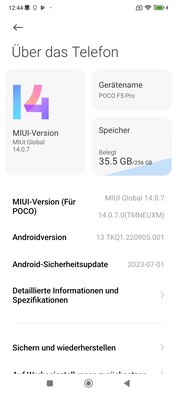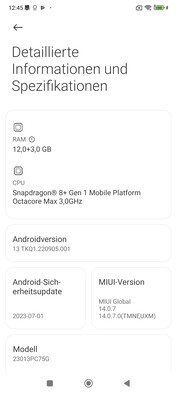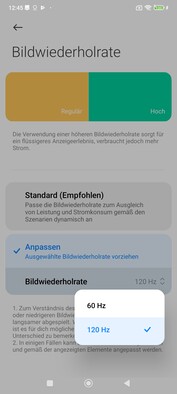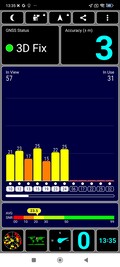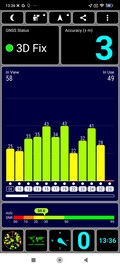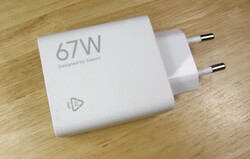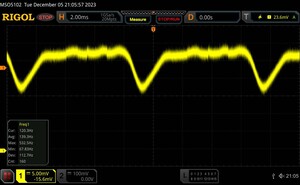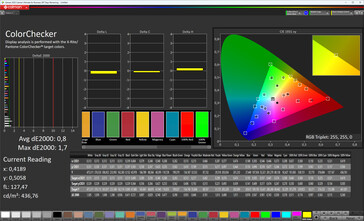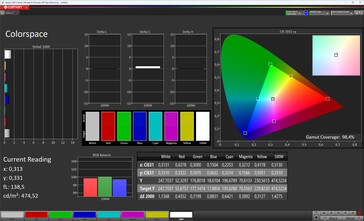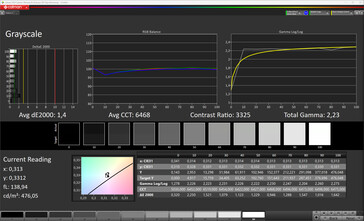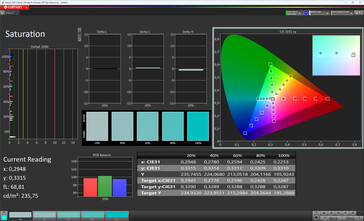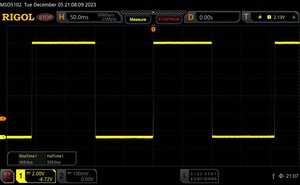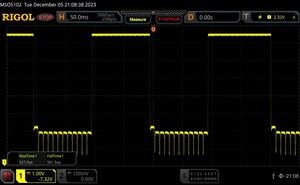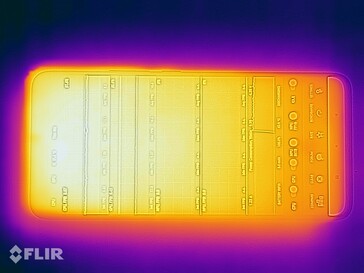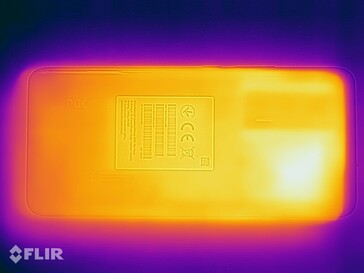Xiaomi Poco F5 Pro review - Powerful mid-range phone with a high-end SoC ↺
The Xiaomi's subsidiary, Poco, has established a reputation for delivering affordable yet feature-rich smartphones. In contrast to the main Xiaomi series, Poco opts for a simpler design, but it is evident that there are few compromises in terms of internal features. This philosophy holds true for the Xiaomi Poco F5 Pro, the latest flagship in the Poco F series, which shares its technical specifications with the Redmi K60, officially available only in China.
Despite competing in the mid-range segment, the 6.67-inch Xiaomi Poco F5 Pro boasts high-end performance powered by the Snapdragon 8+ Gen 1, ensuring longevity without performance bottlenecks. Speed is also a key focus for the Snapdragon 7+ Gen 1-powered Poco F5 performing at a level similar to the Snapdragon 8 Gen 1.
The Xiaomi Poco F5 Pro offers additional appeal with its 3200 x 1440 pixel AMOLED screen (WQHD+), featuring a 120 Hz refresh rate and achieving a peak brightness of over 1000 nits. It is equipped with a triple camera system, including a 64 MP lens with OIS, and a substantial 5160 mAh battery that can be fully charged in less than an hour using a 67-watt charger.
Potential competitors in comparison
Rating | Date | Model | Weight | Drive | Size | Resolution | Best Price |
|---|---|---|---|---|---|---|---|
| 87.4 % | 01/2024 | Xiaomi Poco F5 Pro SD 8+ Gen 1, Adreno 730 | 204 g | 256 GB UFS 3.1 Flash | 6.67" | 3200x1440 | |
| 86.8 % | 09/2023 | Xiaomi Poco F5 SD 7+ Gen 2, Adreno 725 | 181 g | 256 GB UFS 3.1 Flash | 6.67" | 2400x1080 | |
| 87.1 % | 06/2023 | Google Pixel 7a Tensor G2, Mali-G710 MP7 | 193.5 g | 128 GB UFS 3.1 Flash | 6.10" | 2400x1080 | |
| 86 % | 08/2023 | Honor 90 5G SD 7 Gen 1, Adreno 644 | 183 g | 512 GB UFS 3.1 Flash | 6.70" | 2664x1200 | |
| 90.5 % | 03/2023 | Samsung Galaxy S23 SD 8 Gen 2 for Galaxy, Adreno 740 | 167 g | 128 GB UFS 3.1 Flash | 6.10" | 2340x1080 | |
| 87.7 % | 12/2023 | Xiaomi 13T Dimensity 8200-Ultra, Mali-G610 MP6 | 197 g | 256 GB UFS 3.1 Flash | 6.67" | 2712x1220 |
Case - Plastic body with IP53 rating
Xiaomi employs a significant amount of plastic in the construction of the Poco F5 Pro. Both the matte frame and the back are crafted from polycarbonate, marking a notable improvement in tactile feel compared to smartphones in the Xiaomi series.
The back cover, featuring a high-gloss surface and carbon-look edges, exudes a stylish appearance but is prone to collecting fingerprints, particularly in our black color variant. This issue can be mitigated by utilizing the provided protective case.
Thanks to its flat display and rounded back cover along the long sides, the well-crafted Xiaomi Poco F5 Pro offers a comfortable grip, although its weight of 204 grams makes it slightly hefty. The camera module protrudes approximately 2 millimeters from the back, but its flattened sides contribute to a sleeker appearance and improved feel. The display is safeguarded by Gorilla Glass 5, and a protective film is applied at the factory.
In addition to the black test sample, the Xiaomi Poco F5 Pro is also available in white. It boasts IP53 certification, outperforming its counterpart, the Poco F5, providing protection against dust and splash water.
Connectivity - Always-On display and up to 512 GB storage
Three storage options are available for the Xiaomi Poco F5 Pro, with prices posted on the official website as of December 2023. Storage extension using a microSD card is not possible.
- 8 GB + 256 GB: ~$500
- 12 GB + 256 GB: ~$540
- 12 GB + 512 GB: ~$612
The Poco F5 Pro is equipped with WiFi 6, Bluetooth 5.3, NFC, Miracast, stereo speakers, and Dolby Atmos support. An infrared transmitter on the top allows the smartphone to function as a remote control for compatible devices like TVs. Notably, the Poco F5 Pro lacks a 3.5 mm audio jack, which is available only on the Poco F5 in the current Poco F series.
The USB-C port of the Poco F5 Pro operates at USB 2.0 speed but is USB OTG-compatible, allowing connection to peripheral devices (exFAT and NTFS are supported). In a USB copy test with the Samsung 980 Pro in the Asus ROG Strix Arion Case, the USB-C port achieved a data throughput of 31.6 MB/s, a typical value for USB 2.0.
Unlike the Poco F5, the Xiaomi Poco F5 Pro features a 'real' always-on display. While the screen of its counterpart can only be left on temporarily, the AMOLED screen of the Poco F5 Pro can be left on permanently if desired.
Software - Android 13 and an unclear update supply
The Poco F5 Pro operates on Xiaomi's in-house user interface, MIUI 14, which is built on Android 13. As of the testing date in December 2023, the smartphone had Android security patches dated July 1, 2023, indicating that the patches are already outdated.
Xiaomi has not provided specific information regarding the duration of OS upgrades and security updates for the Poco F5 Pro, and the smartphone is not listed in the Xiaomi Security Center. However, it can be assumed that the device may receive OS upgrades for 2 years and security updates for 3 years. While this is a reasonable timeframe, it falls short when compared to competitors. For instance, Samsung offers a more extended support period; the Galaxy S23, for example, receives four OS upgrades and an additional year of security patches.
Communication and GNSS - WiFi 6E and precise GPS
Having a smartphone with WiFi 6E is not common in the mid-range, but the Xiaomi Poco F5 Pro boasts this advanced wireless module. As a result, it achieves impressive transfer rates of up to 1738 MBit/s when paired with our reference router, the Asus ROG Rapture GT-AXE11000, although these rates are not always perfectly stable
While the Poco F5 also supports WiFi 6E, its WLAN performance is slightly inferior to that of the Poco F5 Pro, likely due to differences in the SoC.
Regarding mobile coverage, the Poco F5 Pro offers a slightly more limited range compared to its counterparts in the Xiaomi series. It is well-suited with 15 4G and 12 5G bands, however it may not be the greatest choice for global travel.
| Networking | |
| Xiaomi Poco F5 Pro | |
| iperf3 receive AXE11000 |
|
| iperf3 transmit AXE11000 |
|
| iperf3 transmit AXE11000 6GHz |
|
| iperf3 receive AXE11000 6GHz |
|
| Xiaomi Poco F5 | |
| iperf3 receive AXE11000 |
|
| iperf3 transmit AXE11000 |
|
| iperf3 transmit AXE11000 6GHz |
|
| iperf3 receive AXE11000 6GHz |
|
| Google Pixel 7a | |
| iperf3 receive AXE11000 |
|
| iperf3 transmit AXE11000 |
|
| iperf3 transmit AXE11000 6GHz |
|
| iperf3 receive AXE11000 6GHz |
|
| Honor 90 5G | |
| iperf3 receive AXE11000 |
|
| iperf3 transmit AXE11000 |
|
| Samsung Galaxy S23 | |
| iperf3 receive AXE11000 |
|
| iperf3 transmit AXE11000 |
|
| iperf3 transmit AXE11000 6GHz |
|
| iperf3 receive AXE11000 6GHz |
|
| Xiaomi 13T | |
| iperf3 receive AXE11000 |
|
| iperf3 transmit AXE11000 |
|
| Average of class Smartphone | |
| iperf3 receive AXE11000 |
|
| iperf3 transmit AXE11000 |
|
| iperf3 transmit AXE11000 6GHz |
|
| iperf3 receive AXE11000 6GHz |
|
The Poco smartphone uses GPS (L1), Glonass (L1), Galileo (E1), Beidou (B1), and QZSS (L1) satellite navigation systems, all of which operate on single-band frequencies.
In our practical test, we assessed the Poco F5 Pro's ability to accurately determine its location. The smartphone recorded the distance covered during an approximately 10-kilometer bike ride, and the results were compared to those of the Garmin Venu 2 fitness smartwatch. Despite the differences between the two devices, they exhibited a similarly high level of accuracy. This performance bodes well for all navigation-related tasks, earning a thumbs up for the Poco F5 Pro.
Phone features and voice quality
The Poco F5 Pro has two nano SIM card slots that allow 5G, VoLTE, and Wi-Fi calls. During testing, the smartphone's speech quality was excellent. Calls via mobile and landline networks reproduced callers' voices clearly and intelligibly, with effective filtering out of distracting background noise.
Cameras - Triple camera with 64 MP and OIS
The Xiaomi Poco F5 Pro features a concealed selfie camera with a 16 MP resolution behind a punch-hole cut-out. It is capable of recording videos with a maximum of Full HD at 30 frames per second. Selfies taken with the 16 MP camera exhibit balanced exposure, and the images display good sharpness and dynamics.
On the back, the triple camera setup is led by the OmniVision OV64B. This sensor is responsible for capturing images with the 64 MP main camera (f/1.79), utilizing 4-in-1 pixel binning to produce 16 MP photos (pixel size 1.4 µm) with optical image stabilization support. The main camera also handles zoom shots, achieving up to 10x digital magnification.
In favorable lighting conditions, images from the main camera impress with good sharpness and natural colors. However, in low-light conditions, the difference in quality compared to flagship cameras becomes noticeable, producing very dark and blurred images in the test. The main camera supports video recording with a maximum of 8K at 24 frames per second, while 4K can be recorded at up to 60 FPS. The Poco F5 lacks the 8K recording option. Users can switch between the main and ultra-wide cameras when recording video by adjusting the zoom factor.
The 8 MP ultra-wide-angle camera offers a 120° field of view and delivers solid image quality. Overall, pictures tend to show less detail and are often blurred and distorted at the edges. The third lens in the camera ensemble is a 2 MP macro camera, which, in practice, proves less useful compared to a telephoto camera typically found in higher-priced smartphones.
Image Comparison
Choose a scene and navigate within the first image. One click changes the position on touchscreens. One click on the zoomed-in image opens the original in a new window. The first image shows the scaled photograph of the test device.
Tageslicht-Aufnahme 1Tageslicht-Aufnahme 2Ultraweitwinkel5-facher ZoomLowlight-AufnahmeLastly, under controlled lighting conditions, we analyzed how accurately the main camera could reproduce the reference colors of the ColorChecker color chart. With a maximum Delta-E of 19.23, the main camera revealed significant deviations from the ideal, particularly with darker green and blue tones.
In optimal lighting conditions, the test chart was reproduced sharply with only slight brightening at the edges, an effect that even some high-end cameras might have displayed. Under low-light conditions (1 lux residual light), the main camera's weakness became apparent, as practically nothing of the test chart was visible.
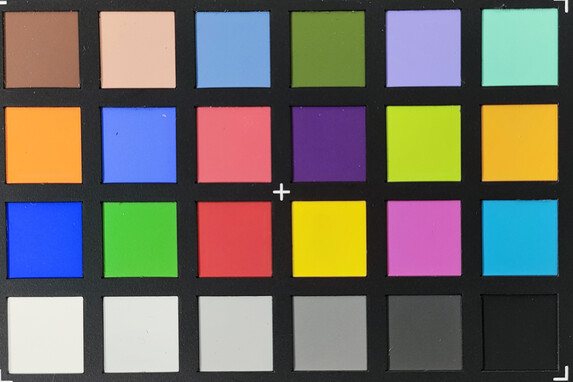

Accessories and Warranty - 67-watt power supply unit included
The scope of delivery includes a 67-watt power adapter, a USB-C cable (Type A to C), a SIM pin, a transparent a protective sleeve, a quick start guide, and two additional leaflets with warranty and safety information.
Xiaomi offers a 24-month warranty on the Poco F5 Pro in the United States.
Input devices & operation - 120 Hz and high touch sampling rate
The AMOLED panel of the Poco F5 Pro operates with a touch sensitivity of 480 Hz, ensuring quick responsiveness to inputs. Combined with a refresh rate of up to 120 Hz, this results in very smooth operation. The vibration motor provides precise feedback.
The fingerprint sensor of the Poco F5 Pro is located under the display and boasts a high recognition rate. Additionally, the device offers biometric authentication through a 2D face scan using the selfie camera. While this method is reliable, it is less secure and requires sufficient ambient light or display brightness to function properly.
Display - Bright AMOLED panel with WQHD+
The Poco F5 Pro's 6.67-inch AMOLED panel exceeds expectations, making it one of the few mid-range smartphones to support dual resolutions. Similar to the Poco F5, it displays content in Full HD (2,400 x 1,080 pixels) as standard. To get an even crisper view, customers can convert from Full HD to WQHD+, which has a resolution of 3,200 x 1,440 pixels, with the Poco F5 Pro's additional display settings option.
In its default setting, the screen dynamically adjusts between 60 and 120 Hz based on the content. Alternatively, users can fix the refresh rate at 60 or 120 Hz. Alongside support for HDR10 and HDR10+, the display also accommodates HLG and Dolby Vision.
Xiaomi claims a maximum brightness of 1400 nits for the Poco F5 Pro's AMOLED panel. In a measurement with an even distribution of bright and dark image areas (APL18), the display achieves a commendable 1224 cd/m², though it falls slightly short of the manufacturer's specification. When displaying HDR content, the AMOLED panel reaches up to 1180 cd/m² in testing.
The AMOLED panel employs pulse width modulation (PWM) for screen brightness control, resulting in unavoidable screen flickering. However, the amplitude curve maintains a constant 120 Hz, which, despite appearing initially low, is consistent across the entire brightness spectrum, contributing to an overall eye-friendly experience. Additionally, Xiaomi uses PWM dimming at a high frequency of 1920 Hz, enhancing comfort for sensitive users.
| |||||||||||||||||||||||||
Brightness Distribution: 95 %
Center on Battery: 1002 cd/m²
Contrast: ∞:1 (Black: 0 cd/m²)
ΔE Color 0.8 | 0.5-29.43 Ø5
ΔE Greyscale 1.4 | 0.57-98 Ø5.3
98.4% sRGB (Calman 2D)
Gamma: 2.23
| Xiaomi Poco F5 Pro AMOLED, 3200x1440, 6.67 | Xiaomi Poco F5 AMOLED, 2400x1080, 6.67 | Google Pixel 7a OLED, 2400x1080, 6.10 | Honor 90 5G AMOLED, 2664x1200, 6.70 | Samsung Galaxy S23 Dynamic AMOLED 2x, 2340x1080, 6.10 | Xiaomi 13T AMOLED, 2712x1220, 6.67 | |
|---|---|---|---|---|---|---|
| Screen | -58% | -15% | -57% | -100% | 10% | |
| Brightness middle | 1002 | 1034 3% | 1006 0% | 1180 18% | 1125 12% | 1254 25% |
| Brightness | 1004 | 1033 3% | 1010 1% | 1202 20% | 1122 12% | 1250 25% |
| Brightness Distribution | 95 | 93 -2% | 95 0% | 88 -7% | 96 1% | 93 -2% |
| Black Level * | ||||||
| Colorchecker dE 2000 * | 0.8 | 1.9 -138% | 1.1 -38% | 1.5 -88% | 3.2 -300% | 0.8 -0% |
| Colorchecker dE 2000 max. * | 1.7 | 3.7 -118% | 2.5 -47% | 4.8 -182% | 4.9 -188% | 1.6 6% |
| Greyscale dE 2000 * | 1.4 | 2.7 -93% | 1.5 -7% | 2.8 -100% | 3.3 -136% | 1.3 7% |
| Gamma | 2.23 99% | 2.24 98% | 2.25 98% | 2.25 98% | 1.97 112% | 2.21 100% |
| CCT | 6468 100% | 6917 94% | 6531 100% | 6489 100% | 6504 100% | 6350 102% |
* ... smaller is better
Screen Flickering / PWM (Pulse-Width Modulation)
| Screen flickering / PWM detected | 120.3 Hz | ||
The display backlight flickers at 120.3 Hz (worst case, e.g., utilizing PWM) . The frequency of 120.3 Hz is very low, so the flickering may cause eyestrain and headaches after extended use. In comparison: 53 % of all tested devices do not use PWM to dim the display. If PWM was detected, an average of 17903 (minimum: 5 - maximum: 3846000) Hz was measured. | |||
Measurement series with fixed zoom level and different brightness settings
The Poco F5 Pro provides users with three color profiles - Vivid, Saturated, and Original Color - to tailor the display settings to their preferences. Additionally, advanced options for adjusting color temperature, color space, and color saturation are available.
Measurement using a spectrophotometer and Calman analysis software reveals that Xiaomi has meticulously calibrated the display at the factory. The AMOLED panel shows optimal color reproduction in the Original Color profile, consistently delivering nearly ideal values for image parameters, including color temperature, gamma, and RGB balance
Display Response Times
| ↔ Response Time Black to White | ||
|---|---|---|
| 1.13 ms ... rise ↗ and fall ↘ combined | ↗ 0.569 ms rise | |
| ↘ 0.559 ms fall | ||
| The screen shows very fast response rates in our tests and should be very well suited for fast-paced gaming. In comparison, all tested devices range from 0.1 (minimum) to 240 (maximum) ms. » 2 % of all devices are better. This means that the measured response time is better than the average of all tested devices (21.5 ms). | ||
| ↔ Response Time 50% Grey to 80% Grey | ||
| 1.09 ms ... rise ↗ and fall ↘ combined | ↗ 0.527 ms rise | |
| ↘ 0.5615 ms fall | ||
| The screen shows very fast response rates in our tests and should be very well suited for fast-paced gaming. In comparison, all tested devices range from 0.2 (minimum) to 636 (maximum) ms. » 2 % of all devices are better. This means that the measured response time is better than the average of all tested devices (33.7 ms). | ||
Outdoors, the Poco F5 Pro's AMOLED panel shines with outstanding readability, efficiently showing content even in direct sunlight. An optional sunlight mode is provided to improve the display's adaptability to bright ambient light. The ambient light sensor demonstrates swift responsiveness to changing light conditions.
Performance - Poco F5 Pro with Snapdragon 8+ Gen 1
Equipped with the Snapdragon 8+ Gen 1, the Xiaomi Poco F5 Pro leverages a high-end SoC from 2022, currently delivering ample power to stand at the forefront. While the Snapdragon 8+ Gen 1's prowess may not set new records in 2024, it ensures a seamlessly smooth system in everyday use, with enough performance reserves for upcoming generations of apps and games.
In comparisons with similarly priced mid-range smartphones, the Poco F5 Pro consistently ranks at the top. In synthetic benchmarks, the Xiaomi smartphone falls behind the Samsung Galaxy S23 which employs the Snapdragon 8 Gen 2 for Galaxy. Noteworthy exceptions include PCMark and the AI benchmarks UL Procyon AI and AImark.
Comparatively, the Poco F5, featuring the Snapdragon 7+ Gen 2 shows only marginal overall performance differences with the Poco F5 Pro in everyday use. Notably, the Poco F5 Pro outperforms its counterpart in AI benchmarks, an area where the Poco F5 shows comparatively lower proficiency.
| UL Procyon AI Inference for Android - Overall Score NNAPI | |
| Xiaomi Poco F5 Pro | |
| Average Qualcomm Snapdragon 8+ Gen 1 (3291 - 84787, n=19) | |
| Google Pixel 7a | |
| Xiaomi 13T | |
| Average of class Smartphone (207 - 84787, n=150, last 2 years) | |
| Samsung Galaxy S23 | |
| Xiaomi Poco F5 | |
| Honor 90 5G | |
Featuring the Adreno 730 GPU, the Poco F5 Pro delivers robust graphics performance. Impressively, it achieves 22 fps in the demanding 4K Aztec Ruins benchmark from GFXBench, indicating smooth gameplay even for high-resolution games. In contrast, the Poco F5, equipped with the Adreno 725 GPU, performs less optimally, particularly in the challenging 3D tests of GFXBench. Despite this, both smartphones exhibit nearly identical speeds in 3DMark.
GFXBench (DX / GLBenchmark) 2.7: T-Rex Onscreen | 1920x1080 T-Rex Offscreen
GFXBench 3.0: on screen Manhattan Onscreen OGL | 1920x1080 1080p Manhattan Offscreen
GFXBench 3.1: on screen Manhattan ES 3.1 Onscreen | 1920x1080 Manhattan ES 3.1 Offscreen
GFXBench: on screen Car Chase Onscreen | 1920x1080 Car Chase Offscreen | on screen Aztec Ruins High Tier Onscreen | 2560x1440 Aztec Ruins High Tier Offscreen | on screen Aztec Ruins Normal Tier Onscreen | 1920x1080 Aztec Ruins Normal Tier Offscreen | 3840x2160 4K Aztec Ruins High Tier Offscreen
| 3DMark / Wild Life Extreme Unlimited | |
| Samsung Galaxy S23 | |
| Xiaomi Poco F5 Pro | |
| Xiaomi Poco F5 | |
| Google Pixel 7a | |
| Xiaomi 13T | |
| Honor 90 5G | |
| 3DMark / Wild Life Extreme | |
| Samsung Galaxy S23 | |
| Xiaomi Poco F5 Pro | |
| Xiaomi Poco F5 | |
| Google Pixel 7a | |
| Xiaomi 13T | |
| Honor 90 5G | |
| 3DMark / Wild Life Unlimited Score | |
| Samsung Galaxy S23 | |
| Xiaomi Poco F5 Pro | |
| Xiaomi Poco F5 | |
| Google Pixel 7a | |
| Xiaomi 13T | |
| Honor 90 5G | |
| 3DMark / Wild Life Score | |
| Xiaomi Poco F5 Pro | |
| Xiaomi Poco F5 | |
| Google Pixel 7a | |
| Xiaomi 13T | |
| Honor 90 5G | |
| 3DMark / Sling Shot Extreme (ES 3.1) Unlimited Physics | |
| Samsung Galaxy S23 | |
| Xiaomi 13T | |
| Xiaomi Poco F5 | |
| Honor 90 5G | |
| Xiaomi Poco F5 Pro | |
| Google Pixel 7a | |
| 3DMark / Sling Shot Extreme (ES 3.1) Unlimited Graphics | |
| Samsung Galaxy S23 | |
| Xiaomi Poco F5 Pro | |
| Xiaomi Poco F5 | |
| Google Pixel 7a | |
| Xiaomi 13T | |
| Honor 90 5G | |
| 3DMark / Sling Shot Extreme (ES 3.1) Unlimited | |
| Samsung Galaxy S23 | |
| Xiaomi Poco F5 | |
| Xiaomi Poco F5 Pro | |
| Xiaomi 13T | |
| Google Pixel 7a | |
| Honor 90 5G | |
| GFXBench (DX / GLBenchmark) 2.7 / T-Rex Onscreen | |
| Xiaomi Poco F5 Pro | |
| Samsung Galaxy S23 | |
| Xiaomi Poco F5 | |
| Xiaomi 13T | |
| Google Pixel 7a | |
| Honor 90 5G | |
| GFXBench (DX / GLBenchmark) 2.7 / T-Rex Offscreen | |
| Samsung Galaxy S23 | |
| Xiaomi Poco F5 Pro | |
| Xiaomi Poco F5 | |
| Xiaomi 13T | |
| Google Pixel 7a | |
| Honor 90 5G | |
| GFXBench 3.0 / Manhattan Onscreen OGL | |
| Xiaomi Poco F5 Pro | |
| Samsung Galaxy S23 | |
| Xiaomi Poco F5 | |
| Xiaomi 13T | |
| Google Pixel 7a | |
| Honor 90 5G | |
| GFXBench 3.0 / 1080p Manhattan Offscreen | |
| Samsung Galaxy S23 | |
| Xiaomi Poco F5 | |
| Xiaomi Poco F5 Pro | |
| Xiaomi 13T | |
| Google Pixel 7a | |
| Honor 90 5G | |
| GFXBench 3.1 / Manhattan ES 3.1 Onscreen | |
| Samsung Galaxy S23 | |
| Xiaomi Poco F5 Pro | |
| Xiaomi Poco F5 | |
| Xiaomi 13T | |
| Google Pixel 7a | |
| Honor 90 5G | |
| GFXBench 3.1 / Manhattan ES 3.1 Offscreen | |
| Samsung Galaxy S23 | |
| Xiaomi Poco F5 Pro | |
| Xiaomi Poco F5 | |
| Xiaomi 13T | |
| Google Pixel 7a | |
| Honor 90 5G | |
| GFXBench / Car Chase Onscreen | |
| Samsung Galaxy S23 | |
| Xiaomi Poco F5 Pro | |
| Xiaomi Poco F5 | |
| Google Pixel 7a | |
| Xiaomi 13T | |
| Honor 90 5G | |
| GFXBench / Car Chase Offscreen | |
| Samsung Galaxy S23 | |
| Xiaomi Poco F5 Pro | |
| Xiaomi Poco F5 | |
| Google Pixel 7a | |
| Xiaomi 13T | |
| Honor 90 5G | |
| GFXBench / Aztec Ruins High Tier Onscreen | |
| Samsung Galaxy S23 | |
| Xiaomi Poco F5 Pro | |
| Xiaomi Poco F5 | |
| Google Pixel 7a | |
| Xiaomi 13T | |
| Honor 90 5G | |
| GFXBench / Aztec Ruins High Tier Offscreen | |
| Samsung Galaxy S23 | |
| Xiaomi Poco F5 Pro | |
| Xiaomi Poco F5 | |
| Google Pixel 7a | |
| Xiaomi 13T | |
| Honor 90 5G | |
| GFXBench / Aztec Ruins Normal Tier Onscreen | |
| Samsung Galaxy S23 | |
| Xiaomi Poco F5 Pro | |
| Xiaomi Poco F5 | |
| Google Pixel 7a | |
| Xiaomi 13T | |
| Honor 90 5G | |
| GFXBench / Aztec Ruins Normal Tier Offscreen | |
| Samsung Galaxy S23 | |
| Xiaomi Poco F5 Pro | |
| Xiaomi 13T | |
| Google Pixel 7a | |
| Honor 90 5G | |
| Xiaomi Poco F5 | |
| GFXBench / 4K Aztec Ruins High Tier Offscreen | |
| Samsung Galaxy S23 | |
| Xiaomi Poco F5 Pro | |
| Xiaomi Poco F5 | |
| Google Pixel 7a | |
| Xiaomi 13T | |
| Honor 90 5G | |
The smartphone excels in fast website loading, quick page rendering, and seamless scrolling. Consistently taking the lead in browser benchmarks, it's worth noting that this performance advantage could be attributed in part to the device running a more up-to-date browser version.
| Jetstream 2 - Total Score | |
| Xiaomi Poco F5 Pro (Chrome 120.0.6099.115) | |
| Samsung Galaxy S23 (Chrome 109) | |
| Xiaomi Poco F5 (Chrome 116) | |
| Average Qualcomm Snapdragon 8+ Gen 1 (76.2 - 178.5, n=21) | |
| Average of class Smartphone (13.8 - 351, n=173, last 2 years) | |
| Google Pixel 7a (Chrome 114) | |
| Xiaomi 13T (Chrome 119.0.6045.163) | |
| Honor 90 5G (chrome 115) | |
| Speedometer 2.0 - Result | |
| Xiaomi Poco F5 Pro (Chrome 120.0.6099.115) | |
| Samsung Galaxy S23 (Chrome 109) | |
| Google Pixel 7a (Chrome 114) | |
| Xiaomi 13T (Chrome 119.0.6045.163) | |
| Average Qualcomm Snapdragon 8+ Gen 1 (69.1 - 167, n=16) | |
| Xiaomi Poco F5 (Chrome 116) | |
| Average of class Smartphone (14.9 - 445, n=157, last 2 years) | |
| Honor 90 5G (chrome 115) | |
| WebXPRT 4 - Overall | |
| Xiaomi Poco F5 Pro (Chrome 120.0.6099.115) | |
| Samsung Galaxy S23 (Chrome 109) | |
| Google Pixel 7a (Chrome 114) | |
| Average Qualcomm Snapdragon 8+ Gen 1 (69 - 159, n=19) | |
| Xiaomi Poco F5 (Chrome 116) | |
| Xiaomi 13T (Chrome 119.0.6045.163) | |
| Average of class Smartphone (22 - 202, n=160, last 2 years) | |
| Honor 90 5G (Chrome 115) | |
| WebXPRT 3 - Overall | |
| Xiaomi Poco F5 Pro (Chrome 120.0.6099.115) | |
| Average Qualcomm Snapdragon 8+ Gen 1 (106 - 224, n=14) | |
| Xiaomi Poco F5 (Chrome 116) | |
| Average of class Smartphone (39 - 304, n=122, last 2 years) | |
| Xiaomi 13T (Chrome 119.0.6045.163) | |
| Octane V2 - Total Score | |
| Samsung Galaxy S23 (Chrome 109) | |
| Xiaomi Poco F5 Pro (Chrome 120.0.6099.115) | |
| Google Pixel 7a (Chrome 114) | |
| Xiaomi 13T (Chrome 119.0.6045.163) | |
| Average Qualcomm Snapdragon 8+ Gen 1 (17622 - 55611, n=22) | |
| Xiaomi Poco F5 (Chrome 116) | |
| Average of class Smartphone (2228 - 89112, n=214, last 2 years) | |
| Honor 90 5G (chrome 115) | |
| Mozilla Kraken 1.1 - Total | |
| Honor 90 5G (chrome 115) | |
| Average of class Smartphone (388 - 9999, n=173, last 2 years) | |
| Xiaomi 13T (Chrome 119.0.6045.163) | |
| Average Qualcomm Snapdragon 8+ Gen 1 (729 - 1707, n=20) | |
| Xiaomi Poco F5 (Chrome 116) | |
| Google Pixel 7a (Chrome 114) | |
| Xiaomi Poco F5 Pro (Chrome 120.0.6099.115) | |
| Samsung Galaxy S23 (Chrome 109) | |
* ... smaller is better
Joined by many mid-range smartphones, the Poco F5 Pro boasts UFS 3.1 memory. This choice ensures rapid charging times and swift data transfers for the Xiaomi device.
| Xiaomi Poco F5 Pro | Xiaomi Poco F5 | Google Pixel 7a | Honor 90 5G | Samsung Galaxy S23 | Xiaomi 13T | Average 256 GB UFS 3.1 Flash | Average of class Smartphone | |
|---|---|---|---|---|---|---|---|---|
| AndroBench 3-5 | 11% | -30% | -21% | -20% | 8% | -19% | -28% | |
| Sequential Read 256KB | 1876.8 | 1798.37 -4% | 1624.39 -13% | 1831.4 -2% | 3133.7 ? 67% 1686.71 ? -10% | 1861.15 -1% | 1760 ? -6% | 1508 ? -20% |
| Sequential Write 256KB | 1773.94 | 1736.41 -2% | 996.44 -44% | 1444.1 -19% | 844 ? -52% 628.53 ? -65% | 1766.12 0% | 1134 ? -36% | 1118 ? -37% |
| Random Read 4KB | 342.04 | 389.37 14% | 229.44 -33% | 226.5 -34% | 427.61 ? 25% 343.65 ? 0% | 380.76 11% | 281 ? -18% | 247 ? -28% |
| Random Write 4KB | 372.35 | 498.93 34% | 263.81 -29% | 260 -30% | 156.69 ? -58% 130.26 ? -65% | 452.08 21% | 311 ? -16% | 272 ? -27% |
Games - Run smoothly even at high resolutions
While not specifically designed as a gaming smartphone, the Poco F5 Pro, powered by the Snapdragon 8+ Gen 1 and Adreno 730 graphics chip, delivers effortlessly smooth gameplay at 60 frames per second for current games, even in high graphics settings. It's worth noting that our test games PUBG Mobile and Genshin Impact did not reach the maximum possible 120 frames per second offered by the AMOLED display.
We assess game frame rates using our Gamebench test tool.
Emissions - Stereo speakers and numerous Bluetooth codecs
Temperature
Under heavy load, the Xiaomi Poco F5 Pro reaches a maximum temperature of 43.3 °C, which is noticeably warm to the touch. It's important to note that this temperature is derived from an extreme scenario, as the burnout benchmark used for this purpose runs for an hour to intentionally raise the smartphone's temperature. In typical daily usage, temperatures are expected to be lower than the average values determined under such extreme conditions.
The Snapdragon 8+ Gen 1 in the Poco F5 Pro exhibits late throttling, allowing it to maintain peak performance for an extended period. For instance, throttling is observed only after 17 out of 20 runs in 3DMark's Wild Life Stress Test. Following this, the Poco F5 Pro experiences approximately a 30 percent reduction in its initial performance.
(±) The maximum temperature on the upper side is 43.3 °C / 110 F, compared to the average of 35 °C / 95 F, ranging from 21.9 to 56 °C for the class Smartphone.
(±) The bottom heats up to a maximum of 42 °C / 108 F, compared to the average of 33.8 °C / 93 F
(+) In idle usage, the average temperature for the upper side is 25.3 °C / 78 F, compared to the device average of 32.7 °C / 91 F.
3DMark Wild Life Stress Test
| 3DMark | |
| Wild Life Stress Test Stability | |
| Honor 90 5G | |
| Xiaomi 13T | |
| Xiaomi Poco F5 | |
| Xiaomi Poco F5 Pro | |
| Samsung Galaxy S23 | |
| Google Pixel 7a | |
| Wild Life Extreme Stress Test | |
| Xiaomi Poco F5 | |
| Xiaomi Poco F5 Pro | |
| Honor 90 5G | |
| Xiaomi 13T | |
| Google Pixel 7a | |
| Samsung Galaxy S23 | |
Speakers
The audio experience on the Poco F5 Pro is delivered through its two stereo speakers positioned on the short sides of the smartphone. These speakers achieve a relatively high volume of 89.4 dB(A) and deliver mids and highs with a linear response. However, bass tones are less pronounced in the sound mix.
For external audio devices, the smartphone offers connectivity options through the USB-C port or Bluetooth 5.3. The Poco F5 Pro supports an extensive range of Bluetooth codecs, including AAC, SBC, LDAC, aptX HD, aptX Adaptive Audio, aptX TWS+ Audio, and LHDC V1 to V5.
Xiaomi Poco F5 Pro audio analysis
(+) | speakers can play relatively loud (89.4 dB)
Bass 100 - 315 Hz
(-) | nearly no bass - on average 27.8% lower than median
(±) | linearity of bass is average (10.3% delta to prev. frequency)
Mids 400 - 2000 Hz
(+) | balanced mids - only 4.8% away from median
(+) | mids are linear (4.9% delta to prev. frequency)
Highs 2 - 16 kHz
(±) | higher highs - on average 6.1% higher than median
(+) | highs are linear (5.6% delta to prev. frequency)
Overall 100 - 16.000 Hz
(±) | linearity of overall sound is average (19.2% difference to median)
Compared to same class
» 19% of all tested devices in this class were better, 8% similar, 73% worse
» The best had a delta of 12%, average was 38%, worst was 134%
Compared to all devices tested
» 41% of all tested devices were better, 7% similar, 52% worse
» The best had a delta of 4%, average was 25%, worst was 134%
Xiaomi Poco F5 audio analysis
(+) | speakers can play relatively loud (90.6 dB)
Bass 100 - 315 Hz
(-) | nearly no bass - on average 25.5% lower than median
(±) | linearity of bass is average (7.4% delta to prev. frequency)
Mids 400 - 2000 Hz
(±) | reduced mids - on average 6.1% lower than median
(+) | mids are linear (5.4% delta to prev. frequency)
Highs 2 - 16 kHz
(±) | higher highs - on average 5.6% higher than median
(+) | highs are linear (5.3% delta to prev. frequency)
Overall 100 - 16.000 Hz
(±) | linearity of overall sound is average (19.2% difference to median)
Compared to same class
» 19% of all tested devices in this class were better, 8% similar, 73% worse
» The best had a delta of 12%, average was 38%, worst was 134%
Compared to all devices tested
» 41% of all tested devices were better, 7% similar, 52% worse
» The best had a delta of 4%, average was 25%, worst was 134%
Battery life - Fully charged in under an hour
Power Consumption
The "Pro" designation sets the Poco F5 Pro apart from the Poco F5 particularly in terms of battery capacity. While the latter boasts a 5000 mAh battery, the Poco F5 Pro features a slightly larger 5160 mAh battery. Additionally, unlike the Poco F5, the Pro version supports wireless charging with a capacity of up to 30 watts.
During testing, using the included 67-watt power adapter, the device took 56 minutes to fully charge from an empty battery. Although this is slightly longer than the 48 minutes stated by Xiaomi, it still represents a notably rapid charging speed.
| Off / Standby | |
| Idle | |
| Load |
|
| Xiaomi Poco F5 Pro 5160 mAh | Xiaomi Poco F5 5000 mAh | Google Pixel 7a 4385 mAh | Honor 90 5G 5000 mAh | Samsung Galaxy S23 3900 mAh | Xiaomi 13T 5000 mAh | Average Qualcomm Snapdragon 8+ Gen 1 | Average of class Smartphone | |
|---|---|---|---|---|---|---|---|---|
| Power Consumption | 2% | 24% | -20% | 42% | -12% | -18% | 1% | |
| Idle Minimum * | 0.93 | 0.89 4% | 0.62 33% | 1.19 -28% | 0.57 39% | 1.13 -22% | 1.015 ? -9% | 0.897 ? 4% |
| Idle Average * | 1.04 | 1.05 -1% | 0.87 16% | 1.71 -64% | 0.74 29% | 1.37 -32% | 1.869 ? -80% | 1.452 ? -40% |
| Idle Maximum * | 1.08 | 1.08 -0% | 0.95 12% | 1.82 -69% | 0.83 23% | 1.42 -31% | 2.02 ? -87% | 1.629 ? -51% |
| Load Average * | 11.27 | 10.86 4% | 6.11 46% | 6.8 40% | 4.26 62% | 8.98 20% | 5.69 ? 50% | 5.55 ? 51% |
| Load Maximum * | 13.84 | 13.49 3% | 11.81 15% | 10.93 21% | 6.16 55% | 13.23 4% | 8.55 ? 38% | 8.31 ? 40% |
* ... smaller is better
Power consumption: Geekbench (150 cd/m²)
Power consumption: GFXBench (150 cd/m²)
Battery life
We conducted practical battery life tests with the screen brightness set to 150 cd/m², while keeping the refresh rate at the default setting.
During the WLAN test, the Poco F5 Pro demonstrated a commendable endurance, lasting a solid 16 hours. When playing an HD video continuously, the smartphone required a recharge after 18 hours and 26 minutes. Comparable devices exhibited similar battery runtimes.
| Xiaomi Poco F5 Pro 5160 mAh | Xiaomi Poco F5 5000 mAh | Google Pixel 7a 4385 mAh | Honor 90 5G 5000 mAh | Samsung Galaxy S23 3900 mAh | Xiaomi 13T 5000 mAh | |
|---|---|---|---|---|---|---|
| Battery Runtime | -4% | -13% | -18% | 12% | 5% | |
| Reader / Idle | 1690 | 1324 -22% | 1328 -21% | 1239 -27% | 2249 33% | 2511 49% |
| H.264 | 1106 | 1123 2% | 1224 11% | 990 -10% | 1255 13% | 1040 -6% |
| WiFi v1.3 | 960 | 1014 6% | 821 -14% | 901 -6% | 926 -4% | 1026 7% |
| Load | 354 | 343 -3% | 252 -29% | 247 -30% | 370 5% | 247 -30% |
Pros
Cons
Verdict on the Xiaomi Poco F5 Pro
Xiaomi has released the fastest Poco smartphone to date, the Poco F5 Pro. This 6.67-inch gadget, powered by the Snapdragon 8+ Gen 1, outperforms other mid-range smartphones significantly. It has remarkable features such as WiFi 6E, a powerful main camera in daylight, fast 67-watt charging, and a long battery life.
While the performance advantage over its counterpart, the Poco F5 (Snapdragon 7+ Gen 2), may not be substantial, the Poco F5 Pro stands out with additional features. Its 120 Hz AMOLED panel supports a fully-featured always-on function, operates with double the touch sensitivity (480 vs. 240 Hz), and boasts a WQHD+ resolution of 3200 x 1440 pixels, distinguishing it from the Poco F5. Furthermore, the Poco F5 Pro exclusively offers IP53 certification and supports wireless charging at 30 watts.
The Xiaomi Poco F5 combines robust features and high performance with a relatively affordable price.
Despite its aspirations to compete in the upper class, the Poco F5 Pro reveals its mid-range status in certain aspects. Notably, its plastic back and frame, while well-crafted, underscore its mid-range identity. The triple camera system could also benefit from improvement, and the uncertainty regarding software updates is a drawback. Additionally, it's worth noting that the 3.5mm headphone jack is only present on the Poco F5.
For those considering alternatives to the Xiaomi Poco F5 Pro, options like the more budget-friendly Poco F5, Google Pixel 7a, and Samsung Galaxy S23 stand out. The latter two, in particular, offer an extended update period of 5 years, surpassing the Poco F5 Pro in this aspect.
Price and availability
The Xiaomi Poco F5 Pro is priced starting at just under $500 at Amazon.
Xiaomi Poco F5 Pro
-
01/04/2024 v7
Manuel Masiero
Transparency
The present review sample was made available to the author as a loan by the manufacturer or a shop for the purposes of review. The lender had no influence on this review, nor did the manufacturer receive a copy of this review before publication. There was no obligation to publish this review.


 Deutsch
Deutsch English
English Español
Español Français
Français Italiano
Italiano Nederlands
Nederlands Polski
Polski Português
Português Русский
Русский Türkçe
Türkçe Svenska
Svenska Chinese
Chinese Magyar
Magyar